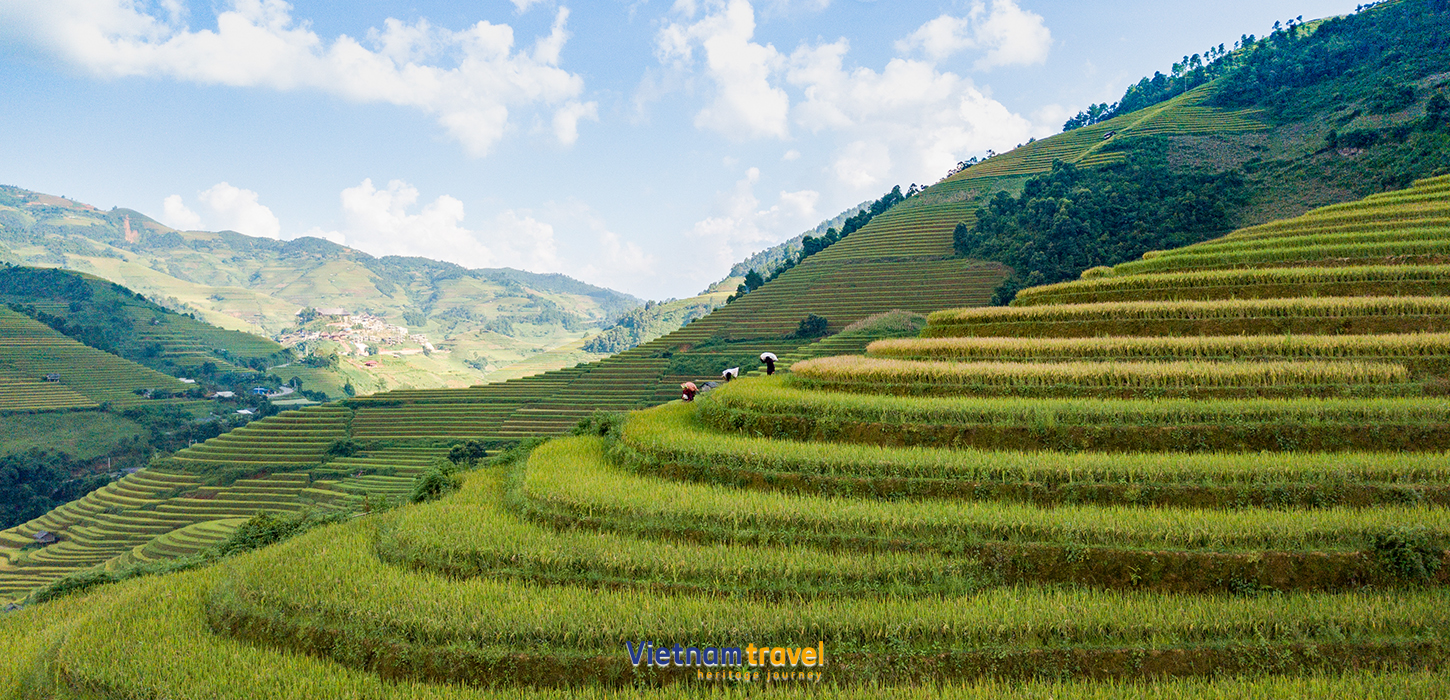Vietnam, with its stunning landscapes, rich culture, and warm hospitality, is a country that captivates travelers from around the world. Among its most iconic and picturesque scenes are the terraced rice fields, which have become a symbol of Vietnam’s agricultural heritage and natural beauty. These rice terraces, often carved into steep hillsides by ethnic minority groups, offer breathtaking views and a glimpse into traditional rural life.
If you’re looking to explore the best places to see rice terraces in Vietnam, in this article Vietnam Heritage Travel will guide you through the top locations, each with its unique charm and appeal, and the best time to visit it during the year.
Sapa – The Legendary Rice Terraces of Northern Vietnam
When talking about rice terraces in Vietnam, the first place that often comes to mind is Sapa. Located in the far northern part of the country, near the Chinese border, Sapa is renowned for its dramatic mountain scenery, misty valleys, and terraced rice fields that seem to stretch on forever. The terraces here are not only a testament to human ingenuity but also a key source of sustenance for the ethnic Hmong, Dao, and Tay people who have cultivated these fields for generations.
The best time to visit Sapa’s rice terraces is during the rice-growing season from May to September. The terraces are lush and green in the early months, and by September, the rice fields turn a golden hue, ready for harvest. The Muong Hoa Valley is one of the most beautiful areas in Sapa to view the terraces, with cascading layers of rice paddies descending the mountainsides.
For those looking to fully immerse themselves in the experience, Sapa offers various trekking opportunities through the rice terraces and local villages. Staying in homestays with ethnic minority families provides an authentic cultural experience, allowing travelers to learn more about the traditional farming practices and customs.
Tours to visit Sapa:
Amazing North Vietnam – 6 days/ 5 nights

The best time to visit Sapa’s rice terraces is during the rice-growing season from May to September. Photos source: Internet.
Mu Cang Chai – The Remote Beauty
For a more off-the-beaten-path adventure, Mu Cang Chai is an exceptional destination for rice terraces. Located about 300 kilometers northwest of Hanoi, Mu Cang Chai is known for its remote, untouched beauty and terraced fields that climb the steep mountains. The journey to Mu Cang Chai takes travelers through winding roads, deep valleys, and passes, but the reward is the spectacular sight of some of the most beautiful and expansive rice terraces in Vietnam.
The rice terraces of La Pan Tan, Che Cu Nha, and De Zu Phinh are particularly famous and have been recognized as a national heritage site by the Vietnamese government. These terraces are carved into nearly vertical slopes, showcasing the impressive skill of the local Hmong people, who have maintained this tradition for centuries.
The best time to visit Mu Cang Chai’s rice terraces is during the harvest season in the mid September and early October, the terraces turn golden, offering a truly magnificent sight.
Mu Cang Chai also hosts the annual Mu Cang Chai Rice Terrace Festival, where visitors can experience the region’s cultural heritage through traditional dances, music, and rice-harvesting competitions.

Mu Cang Chai is an exceptional destination for rice terraces. Photos source: Internet.
Hoang Su Phi – The Hidden Gem of Ha Giang
Located in Ha Giang Province, one of Vietnam’s most remote and least visited regions, Hoang Su Phi is a hidden gem when it comes to rice terraces. The area’s remoteness adds to its allure, as fewer tourists venture here compared to Sapa or Mu Cang Chai, making it an ideal destination for those seeking a more peaceful and authentic experience.
The rice terraces in Hoang Su Phi are spread across several communes, including Ban Luoc, Ban Phung, and Thong Nguyen, where ethnic groups like the Red Dao, Tay, and La Chi live. The terraces are carved into some of the steepest hillsides in Vietnam, creating intricate patterns that are especially striking in the early morning when the mist hangs low over the mountains.
Hoang Su Phi is best visited during the harvest season from September to October, but its unique charm lies in its year-round beauty. The area’s wild and rugged landscape, combined with its vibrant cultural traditions, make it one of the most special places to visit rice terraces in Vietnam.
Magnificent sight of rice terraces in Thong Nguyen village of Hoang Su Phi. Photos source: Internet.
Y Ty – A Lesser-Known Paradise
Y Ty, a lesser-known destination compared to Sapa or Mu Cang Chai, is located in Lao Cai Province, near the Chinese border. Perched at an altitude of over 2,000 meters, Y Ty is a hidden paradise with some of the most beautiful rice terraces in northern Vietnam. The area is home to several ethnic minority groups, including the Ha Nhi people, who are known for their unique way of cultivating rice on the steep mountainsides.
Y Ty’s terraces are unique in their layout, often following the natural contours of the land, creating sweeping curves and patterns that are mesmerizing to behold.
The best time to visit is from May to October, with the rice fields at their most beautiful during the harvest season in September.
What sets Y Ty apart is its serenity and lack of commercialization. This area remains relatively untouched by mass tourism, making it an excellent destination for travelers looking for an authentic, tranquil experience in nature. The Ngai Thau and A Lu communes are particularly famous for their stunning terraced fields.

Rice terraces in water-pouring season in Y Ty. Photos source: Internet.
Pu Luong Nature Reserve – A Tranquil Escape
For those looking to experience the beauty of rice terraces without traveling too far from Hanoi, Pu Luong Nature Reserve is an ideal option. Located about 170 kilometers southwest of the capital, Pu Luong is a relatively easy-to-reach destination that offers a mix of natural beauty, rice terraces, and traditional village life.
Pu Luong’s rice terraces are set against a backdrop of lush forests, limestone mountains, and winding rivers. The terraces here are much less crowded than those in Sapa or Mu Cang Chai, making it a perfect destination for a tranquil escape. The local Thai and Muong people have farmed these terraces for generations, and visitors can learn about their sustainable agricultural practices and daily lives.
The best time to visit Pu Luong is from May to June, when the fields are bright green with new rice shoots, or from September to October, when the golden harvest season is in full swing. Pu Luong also offers a variety of eco-friendly accommodation options, including homestays and eco-lodges, providing a comfortable base for exploring the terraces and nearby attractions.

Trekking in Puluong during ripe rice season. Photos source: Internet.
Ta Van – A Picturesque Village Near Sapa
If you’re visiting Sapa but want to explore an area with fewer tourists, head to Ta Van, a small village located just a few kilometers from Sapa town. Nestled in the Muong Hoa Valley, Ta Van is home to the Giay people and offers beautiful rice terraces that are equally as stunning as those in Sapa but with a more peaceful atmosphere.
The terraces here are often shrouded in mist in the early morning, creating a mystical ambiance that’s perfect for photography. Ta Van is also an excellent starting point for trekking routes that lead through the rice fields and neighboring villages, providing a more intimate experience with the local culture.
Visitors can stay in traditional homestays in Ta Van, where they can enjoy meals cooked with fresh local ingredients and immerse themselves in the daily lives of the Giay people.

Ta Van is an excellent starting point for trekking routes that lead through the rice fields and neighboring villages. Photos source: Internet.
Bac Son Valley – A Hidden Gem in Lang Son Province
Bac Son Valley, located in Lang Son Province in northern Vietnam, is another hidden gem for those looking to explore rice terraces. While less famous than Sapa or Mu Cang Chai, Bac Son offers some of the most dramatic landscapes in the country. The rice terraces here are spread across a wide valley surrounded by towering karst mountains, creating a stunning contrast between the bright green or golden rice fields and the rugged peaks.
One of the highlights of visiting Bac Son is the opportunity to climb to the top of Na Lay Mountain, which offers a panoramic view of the entire valley. From this vantage point, visitors can see the patchwork of rice terraces, rivers, and small villages below, making it one of the best spots for photography in the region.
The best time to visit Bac Son is in July, when the rice fields are in their full green splendor, or in November, when the valley turns golden during the harvest season. Bac Son remains relatively unknown to tourists, so it’s a great destination for those looking to experience the beauty of Vietnam’s rice terraces in a peaceful, unspoiled setting.

Bac Son valley comes to harvest rice season. Photos source: Internet.
Mai Chau – A peaceful valley in Western Hanoi.
Mai Châu, located in northern Vietnam, is a peaceful valley known for its picturesque rice fields, traditional stilt houses, and ethnic Thai and Muong communities. While it doesn’t feature the steep, dramatic terraces found in Sapa or Mu Cang Chai, Mai Châu’s rice fields stretch across a flat valley floor, framed by rolling hills and limestone mountains. The green or golden hues of the rice paddies create a stunning patchwork landscape that captures the charm of rural Vietnam.
The best time to visit Mai Châu for its rice fields depends on the season you prefer:
- May to June: This is the growing season when the fields are lush, green, and vibrant. It’s an excellent time for scenic walks and photography as the rice plants are thriving.
- September to October: During the harvest season, the fields turn a golden yellow, providing stunning views of the countryside. It’s also a chance to witness local farmers harvesting the rice using traditional methods.
Whether you want to trek through the rice paddies, cycle through the valley, or stay in a traditional homestay, Mai Châu offers a serene and culturally rich experience for nature lovers and cultural enthusiasts.
Tours to visit Mai Chau
A glimpse of North Vietnam – 7 Day/ 6 Nights

Mai Châu is a peaceful valley known for its picturesque rice fields. Photos source: Internet.
Conclusion
Vietnam’s rice terraces are a testament to the country’s agricultural heritage and the hard work of its ethnic minority communities. From the famous terraced fields of Sapa to the hidden gems of Hoang Su Phi and Bac Son, each region offers its unique landscapes, culture, and experiences. Whether you’re looking to trek through the fields, stay with local families, or simply take in the breathtaking views, these destinations provide a window into the heart of rural Vietnam.
No matter where you choose to go, visiting the rice terraces of Vietnam is an unforgettable experience that will leave you with lasting memories of this beautiful country’s natural wonders and cultural richness.




Comment (0)